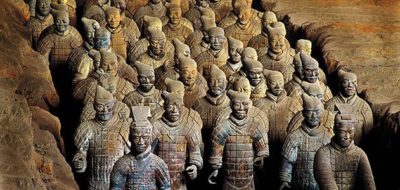The terracotta army of Qin Shi Huang, the First Emperor of the Han Dynasty (ruled 221-210 BCE), has captured the world’s attention since its first discovery in the 1970s. The thousands of marionette-like figures standing in formation testify to an administration that had achieved unprecedented military power. The First Emperor’s famous assemblage, however, was not the last terracotta army to be commissioned. His original assemblage inspired a long line of clay armies in the Western Han dynasty (202 BCE-9 CE). This presentation will examine these new army figurines and their relationship to the Qin precedent, reflecting on their unique style and considering what the armies reveal about warfare and politics in China’s first long-lasting empire.
Allison Miller specializes in Chinese art and archaeology. She holds a Ph.D. from Harvard University (2011) in East Asian Languages and Civilizations (EALC) and Art History and an A.B. from the University of Chicago (2003) in Classics and EALC. She is currently Associate Professor of Art History at Southwestern University near Austin, Texas. Her research has been supported by Harvard’s Asia and Fairbank Centers and the Fulbright Foundation. She was also a 2017-2018 lecturer for the Archaeological Institute of America (AIA).
As an art historian with an interdisciplinary approach, Miller’s research investigates the relationship of visual forms to political history and contexts of artistic production. Her forthcoming book, Kingly Splendor: Materiality and Royal Art in Han China, highlights the important role played by elites outside of the capital region in stimulating five important transitions in early Han funerary art: 1) rock-cut tombs, 2) miniature terracotta armies, 3) jade suits, 4) wall murals, and 5) purple dyes and pigments. The study shows how the structure of the early Han empire—with the emperor as one amongst peers—profited artistic production in a way that would not occur after the empire became more centralized, resulting in the development of artistic genres that would form the basis of Chinese funerary art for the remainder of pre-modern Chinese history.
During her time at ISAW, Miller will write a history of color in ancient China. She will investigate the chief dyes and pigments used in China’s antiquity, the process by which they were acquired and produced, and the meanings associated with specific colors. The project will reveal not only the ways that the Chinese cultivated and utilized their own mineral and vegetal resources, but also the dynamic impact of long-distance trade and exchange on early imperial Chinese society.


